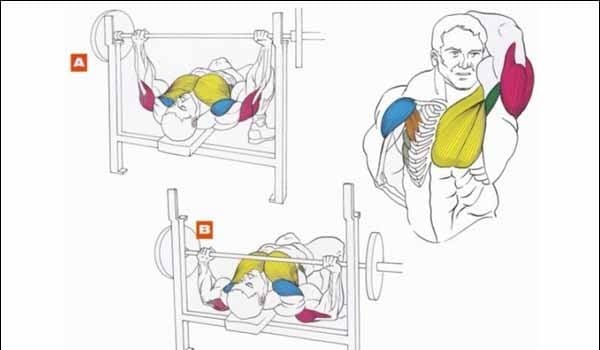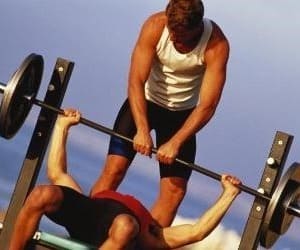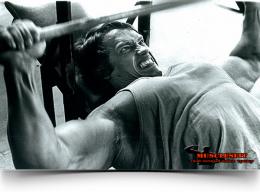Bench press - a direct path to the world of strength and volume of the pectoral muscles
Large and prominent pectoral muscles have always been held in high esteem. But, in order to make them so, you need to train hard, using effective exercises.
The basic exercise for working out the chest is the well-known bench press. Of course, it is one of the most popular ways to increase the muscle volume of the chest.
Also, this exercise involves the shoulder girdle and arms. In this article, we will take a closer look at the bench press, the correct technique for its implementation and common mistakes, as well as world records of strongmen.
The bench press is a multi-joint basic physical exercise using free weights (free weights include loose equipment such as barbells, kettlebells, dumbbells).
Due to the fact that this exercise involves a significant part of the muscles of the upper body and allows you to achieve a complex increase in their strength and mass, it is an indispensable element of the training process for athletes of various directions.
Also, the bench press exists as an independent sport and one of the three disciplines in powerlifting - powerlifting.
Muscles involved
The main work in the bench press is performed by the large and small pectoral muscles, which are responsible for the movement of the arms in relation to the body and the separation of the shoulder blades.
The assistants are the anterior deltas, serratus anterior, coracobrachialis, and triceps. In different versions of the bench, the load is distributed in a certain way, loading the specific muscle groups listed above with the target effect.
The antagonist muscles in the bench press are the latissimus dorsi and biceps.

Varieties
A complete classification of the whole variety of bench press options is worthy of a separate book, but if we omit purely powerlifting practices and unpopular unusual bench presses (for example, on the floor), then it is worth highlighting the following variations applicable in bodybuilding.
1. Grip width can be classic (medium), wide and narrow. In the classic grip, the palms are slightly wider than the shoulders, which usually corresponds to a distance of 50-60 cm.
It balancedly distributes the load on all the muscles involved in the exercise, without creating its distortion. On the other hand, such versatility does not allow you to fully work out any muscle group.
Therefore, for point loading of a specific muscle group, you need to use more specialized grips: wide and narrow.
A wide grip suggests a greater distance between the palms than a classic grip and significantly engages the pectoral muscles and those areas that are inaccessible to working out with a classic grip.
With a wide grip, many athletes are tempted to use the chest as a shock absorber, “beating off” the barbell from it when lowering. This is a gross violation of the technique of performing the exercise, since the “beating off” knocks down the rhythm of breathing and increases the risk of injury to the chest.
A narrow grip works the triceps to a greater extent, and the space between the hands is minimal here.
People with weak hands should be careful when performing this bench press variation, because the narrow grip of the bar significantly increases the pressure on the wrist joint.
2. Interesting ways to hold the bar are also reverse and open grips.
The reverse grip differs from the direct grip in that here the palms are turned towards the athlete, and not away from him.

This allows you to reduce the load on the hands and use the biceps more as a stabilizer, which makes this exercise suitable for training it.
In the reverse grip, it is worth doing multi-repetition approaches and taking relatively small weights (to avoid elbow injury), and only remove the barbell with a partner, since it is simply impossible to do it alone.
The open grip is peculiar in that here the thumb does not “lock” the fist, clasping the bar from the side opposite to the rest of the fingers, but rests on the same side.
Of course, this is very dangerous and the athlete can easily drop the barbell on his chest with extremely negative consequences, but it is believed that opening the finger “lock” allows you to connect the triceps more strongly and increase the weight being lifted.
In any case, this is a huge risk, which is categorically not recommended for non-professional athletes.
3. The bench press in the upper slope is performed on a bench raised by 30-40 degrees, the load is directed to the deltas and the upper part of the pectoral muscles. Compared to the classic bench press, the weight on the bar should be less.
The bench press in the lower incline engages the deltoid muscles and the lower pectoral muscles, is also undemanding to the weights on the bar and is not recommended for people with increased intracranial pressure. The legs should be securely fastened behind the bench, and it is better to remove the bar with a partner.
4. The bench press in the Smith machine is safer and does not require the expenditure of energy on independent control of the range of motion. However, it only complements, and does not replace, the free weight press, allowing you to place small accents in the training process.
5. The meaning of the bench press with chains or rubber is to change the load depending on the distance between the barbell and the chest: the closer the projectile is to it, the easier the load, the farther away, the more it intensifies.
Classic Bench Press Technique
Starting position: lying on the bench, the head, shoulders and buttocks touch it, the feet are shoulder-width apart and pressed to the floor, the shoulder blades are brought together.
The end point should be the lower chest area, approximately in the nipple area. The projectile should only slightly touch the chest, and not be placed on it.
During the movement, it is worth making sure that the forearms always remain perpendicular to the floor. The hands do not break too far back, as this puts too much stress on them and can unbalance the movement.
Elbows should not be spread too far and pressed too close to the body, their optimal position is 45 degrees in the horizontal plane.
The bar must be lowered rather slowly, while the rise is carried out with a more explosive movement. Inhalation is done while lowering, exhalation is done while lifting.
1) Severe arching of the back, known in powerlifting as a "bridge", is undesirable in the bodybuilding press. The bridge aims to maximize the weight being lifted by distributing the load throughout the body and removing some of the load from the target muscles, that is, it is cheating.

In addition, a good bridge requires its setting with a trainer and the presence of sufficient stretching, and therefore, with independent exercises aimed at muscle growth, its use can be hazardous to health. Allow only a slight, natural back deflection.
2) The need for a warm-up is obvious, in the bench press one should pay attention to warming up not only the pectoral muscles and the shoulder joint, but also the warm-up of the feet and wrist joint, as well as the lower back, a significant part of the passive load is imposed on them.
3) Progression both in strength indicators and in muscle mass is possible when auxiliary exercises are included in the training program, which work out the muscles involved in the bench press in different ways. These can be push-ups on the uneven bars, bench press and wiring (lying) of dumbbells, pullovers, etc.
4) The increase in weight on the bar should be gradual: more benefit will be from adding a kilogram per week than from five kilograms at a time at the end of the month. It is easier for the body to adapt to such a smooth increase in loads, and it may not pull a sharp jump in weights, and the result will be stagnation.
5) It is desirable to have a partner who will help remove the barbell from the racks, provide insurance and be able to correct the technique, watching the process from the side.
If you do not have a partner, and you are doing it alone, it is not recommended to attach locks to the bar, since in the event of an unsuccessful lifting of the weight, it should always be possible to drop it to the floor.
Runtime errors
- Separation of heels from the floor and legs “walking” on it.
- Unflattened shoulder blades, as a result of shoulders not fixed on the bench and excessive inclusion of the trapezius muscles.
- Forearms and hands thrown back.
- Unstable position of the elbows.
- Cheating with a powerlifter bridge, especially if the athlete is not engaged in special strength training.
- Neglect of warm-up, insurance and other elements of safety.
- Too sharp increase in weights, a fanatical desire for their constant increase at the cost of developing technique.
- Separation of the pelvis from the bench
For a long time on the territory of the USSR, weightlifting was considered the only officially recognized sport, in which the bench press was only a secondary auxiliary exercise.
Everything changed in the 1980s, when all-Union competitions in disciplines began to be held, which included the bench press.
During these years, Open Championships in classical powerlifting triathlon were held in the Lithuanian SSR. In 1988, the first international meetings of the USSR and the USA in powerlifting took place.

In the United States, this sport has a longer history, so it is not surprising that the Americans noted the poor performance technique and remnants of weightlifting movements in Soviet athletes.
However, all these absurdities were quickly corrected, and, since the 1990s, Russian powerlifting has kept pace with the American in its success.
Russian benchers have inscribed their names in the pantheon of power glory: Kirill Sarychev, Vladimir Kravtsov and many others. Not far behind are the countries of the near abroad: Ukraine and Belarus.
To date, the bench press is presented as an independent discipline of the same name in the classic bench press to lift the maximum weight, as well as in the "Russian bench press", where it is necessary to lift a certain weight at times.
In the classic bench press, they compete in the equipped and unequipped divisions, with and without doping control. The standards are sorted by weight categories and sports titles (II youth category - I adult, CMS, MS, MSMK, elite). There are many federations.
Ryan Keneally conquered the weight of 486 kg, using verbose equipment. This is the absolute world record in the press. Fredrik Smulter holds the record in single ply with 400kg.
Kirill Sarychev, who took the weight of 335 kg in 2015, holds the palm in the unequipped bench press.
An interesting example is Maryana Naumova, who shook 60 kilograms at the age of 11. This is an absolute world record among girls under 14 years old in a bare bench press. For such an achievement, Maryana was awarded a place in the Russian Book of Records.
Brief summary
The bench press is a basic exercise that fully develops all the muscles of the upper body: pectoral, triceps, deltoid. Its benefits for increasing muscle mass are undeniable.
A huge number of options for this exercise allows you to find a place for it in the training process of any athlete who chooses one or another of its varieties based on their interests. 5-15 repetitions will be optimal for a bodybuilder.
The correct setting of the technique will avoid injuries and evenly involve all the muscles working in the exercise. It is better to avoid mistakes during the mastering stage than to try to correct them when the wrong technique is already fixed and deposited in muscle memory.
Useful video
Live and learn! Watch the video with the correct bench press technique:
Fitness trainer, group exercise instructor, nutritionist
Conducts general consultations on nutrition, selection of a diet for pregnant women, weight correction, selection of nutrition for exhaustion, selection of nutrition for obesity, selection of an individual diet and therapeutic nutrition. He also specializes in modern methods of functional testing in sports; athlete recovery.






